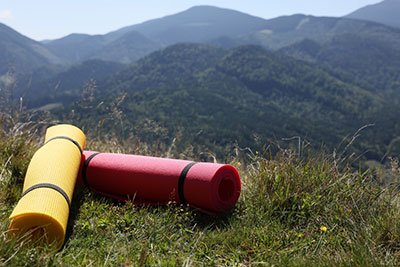Are you looking for the best way to stay warm and comfortable while camping or backpacking this summer? Sleeping pads and underquilts are both great options, but which one is right for you? We’re here to help!
In this blog post, we’ll compare sleeping pads and underquilts in terms of comfort, warmth retention, ease of setup, packability, and price.
Read on for our comprehensive comparison to find out who's the best!
More...
Take Away Key Points:
- When you intend to sleep cold at night but need warmer gear, you can use the quilt or sleeping pad to make your warmer
- Both solutions are effective warm gear for colder air, but a quilt might be a netter as you can use it as a top quilt or underquilt, and it provides better protection than a pad
- However, quilts are more expensive than pads and might require bungee cords for easier installation. So, weigh all pros and cons before the final decision
Sleeping pad vs. underquilt: Who's the boss?
If you cannot decide between the hammock sleeping pad or underquilt for a comfortable night while camping, read our comparison. The outcome depends on your personal preference, but we will offer some insights for your comfortable sleep. Let's start!
What is a hammock sleeping pad?

A hammock sleeping pad is a type of hammock camping gear designed to provide insulation and comfort for those who sleep in a hammock. It is usually an inflatable or foam pad in square versions. It fits inside the double-layered hammock and provides cushioning and warming effects to most people.
The most common type of sleeping pad for hammock camping is an inflatable mattress similar to what you would use on the ground, but some are more specifically designed for hammocks, such as the Klymit Insulated Hammock V Sleeping Pad.
In addition to providing insulation, the sleeping pad can also help keep you from rolling off while sleeping in a hammock.
Advantages & disadvantages of sleeping pads
The hammock sleeping pad is a great option for hammock camping and offers many advantages over a traditional sleeping pad.
Here are some of the pros and cons of using a hammock sleeping pad:
1. Sleeping pad pros
- Comfort: Many people find sleeping in a hammock more comfortable than sleeping on the ground, as it allows them to spread out and utilize inflatable sleeping pads.
- Versatility: Hammocks are much easier to set up than tents, making them an ideal choice for campers who want to move quickly from one spot to another. Additionally, they can be used in places where tents cannot, such as rocky or uneven terrain
- Insulation: Sleeping pads provide insulation from cold conditions, ensuring you're staying warm and cozy while you sleep. They also help protect against moisture and bugs.
- Cost: Hammocks are generally less expensive than tents, making them an affordable option for campers on a budget.
2. Sleeping pad cons
- Space: Foam pads can be cramped compared to tents, which offer more room for movement and storage. Additionally, they may not fit two people comfortably.
- Noise: The crinkly material of some foam pads can make a noise that keeps you up all night or disturbs nearby campers.
- Weather conditions: Hammocks may not be suitable for extreme weather conditions such as heavy rain or strong winds, as they may not provide enough protection and entire body heat from the cold air.
What is a hammock underquilt?

An underquilt is an insulated quilt designed to hang underneath your hammock to prevent heat loss. It looks like a sleeping bag and functions similarly, but it's specifically designed for use with a hammock. The insulating layer of an underquilt helps keep you warm in cold weather, while also protecting you from wind and rain.
Underquilts come in different sizes and shapes to fit different types of hammocks, and they can be filled with either synthetic or down insulation depending on the user's needs. They are typically lightweight and easy to set up, making them ideal for camping trips or other outdoor activities.
Advantages & disadvantages of hammock underquilts
Hammock underquilts are an increasingly popular way to stay warm and comfortable while camping in a hammock. They provide insulation from the cold ground and can be used in combination with sleeping pads or blankets for extra warmth.
While they offer many advantages, there are also some disadvantages to consider when deciding if a hammock underquilt is right for you.
Underquilt pros
- Proper insulation: One of the main advantages of using an underquilt is that it provides superior insulation from cold ground. Unlike sleeping pads, which can lose their insulating properties and body heat over time, quilts retain their warmth and warm air inside even after multiple uses. Additionally, because it attaches directly to the bottom of your hammock, it eliminates any cold spots created by shifting around during sleep.
- Ease of use: Another advantage of using a hammock underquilt is that it is lightweight and easy to set up. It typically comes with straps that attach quickly and easily to your hammock’s suspension system. You don’t have to worry about spending time setting up complicated knots or tying off loose ends.
Underquilt cons
- Pricey: The main disadvantage of using a hammock underquilt is that it can be expensive compared to other forms of insulation such as sleeping pads or blankets. Additionally, because they are designed specifically for use with a hammock, they may not be suitable for other types of camping trips where you need more flexibility in terms of insulation options.
- Lack of warmth: Another potential downside of using an underquilt is that it may not provide warmth for extremely cold temperatures. If you plan on camping in temperatures below freezing, you may want to consider combining your underquilt with insulating layers such as blankets or sleeping bags for keeping warm atmosphere inside tent camping.
Sleeping pad or underquilt: A full comparison
Below you can find crucial factors to compare the two hammock units for your best camping experience:

1. Warmth & protection
On the one hand, an underquilt provides superior warmth and protection from the elements. It hugs your body and gives a soft, almost cocoon-like feeling that is unmatchable with a pad.
On the other hand, sleeping pads are easily packable and take up less space when stored in your backpack. So which is better?
If you’re looking for maximum comfort in cold weather conditions, then an underquilt is the clear winner. It will keep you warm and snug even in extreme temperatures.
2. Ease of use
When it comes to ease of use, the hammock underquilt is the clear winner. Unlike a sleeping pad, an underquilt is designed to fit around the bottom of your hammock and provide insulation without having to be inflated or adjusted.
This makes it much easier and faster to set up than a sleeping pad, which requires you to inflate it and adjust it for comfort. Additionally, an underquilt can provide more warmth than an inflatable pad since it wraps around your body rather than just lying underneath you.
3. Durability
Hammock underquilts are generally made of lightweight materials, making them more susceptible to tears and punctures than sleeping pads. However, underquilts are often made of high-quality synthetic materials or down, which can be very durable over time if taken care of properly.
Additionally, underquilts are usually stored in a dry bag or stuff sack when not in use, protecting them from the elements and ensuring they last longer.
Most sleeping pads, on the other hand, are typically made of more durable materials, such as PVC or TPU-coated nylon, making them resistant to tears and punctures. However, they can lose their durability over time if not stored properly or if exposed to harsh weather conditions.
Overall, while sleeping pads may be initially more durable than underquilts, proper care, and storage can make both options last a long time. In terms of durability, it's a tie between the two options.
4. Portable and lightweight design
When it comes to portability and lightweight design, sleeping pads are the winner. Sleeping pads can be compressed down to a very small size and easily fit in your backpack, while hammock underquilts are typically bulkier and harder to pack down. Additionally, sleeping pads are typically lighter than underquilts, making them even easier to carry during your camping trips.
While underquilts provide superior warmth and protection from the elements, they're not as lightweight or compact as sleeping pads, which makes them more difficult to transport. If you're looking for something easy to pack and won’t take up much space, then a sleeping pad is a better option for your needs.
5. Easy-to-clean features
The hammock underquilt is the clear winner. Unlike sleeping pads, which can be difficult to clean and require special care, underquilts are much easier to keep clean.
They can be easily wiped down with a damp cloth or even thrown in the washing machine if needed. Additionally, they don't need to be inflated like sleeping pads, so there's no need for extra maintenance or worrying about punctures.
6. Price
Regarding price, sleeping pads are generally more affordable than hammock underquilts. Sleeping pads have been around for a long time and are available at a wide variety of price points, from budget options to high-end pads with more advanced features. As a result, it's easy to find a sleeping pad that fits your budget.
Hammock underquilts, on the other hand, are relatively new to the market and tend to be more expensive than sleeping pads. They require specialized materials and design, making them a bit of a luxury item for hammock campers. While there are some budget options available, higher-end underquilts can cost several hundred dollars.
Is a sleeping bag a good alternative for tent camping?
A sleeping bag can sometimes replace the underquilt or pad, but, you'll want to make sure the sleeping bag is designed for the temperature range and conditions of your camping trip.
For colder temperatures, you may want to consider other alternatives, such as a down sleeping bag with a higher fill power rating. The down sleeping bag is typically more compressible than synthetic bags, making them ideal for backpacking trips. However, this sleeping bag is more expensive and requires special care when washing and drying.
FAQs
Can you use a sleeping pad instead of an underquilt?
Yes, you can use a sleeping pad instead of underquilt to keep your body temperature optimal while sleeping on the ground when you hang in a tent at night.
Do you need an underquilt for a hammock?

No, you don't necessarily need a quilt underneath your hammock to keep you warm. But, in the winter, cold air, and freezing night, need a quilt as a single layer of protection of most hammocks won't be enough for a warm body and sleep.
Should I use a sleeping pad in my hammock?
Yes, you should use a pad in your hammock, but it might be troublesome to install it properly. You can also place the pad inside the sleeping bag for the night.
Underquilts vs. pads: Final verdict
Both sleeping pads and underquilts are ideal options to keep you warm during the night. However, there is only one winner and this is the quilt. Let's see the final chart:
Items | The winner |
|---|---|
Warmth | Quilt |
Ease of use | Quilt |
Durability | Both |
Portability | Sleeping pad |
Easy to clean | Quilt |
Price | Sleeping pad |
So, if you need top gear for your hammock adventure, the quilt is the best solution for a cold night!

Hi there, I am Orson Brown, a passionate explorer and the one behind Stop, Reset! Do you like hiking, climbing or camping, but don’t know how to get started? Follow our journey to prepare your trip best!
